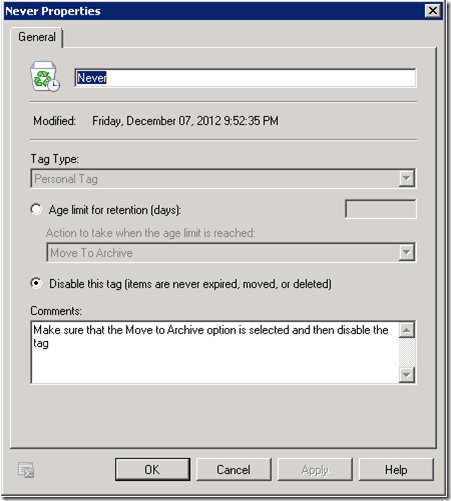Stamping Archive Policy Tag using EWS Managed API from PowerShell(Exchange 2010)
In a previous post I had explained how to stamp a Retention Policy Tag using EWS Managed API, In this post I will explain the changes you will need to make to stamp an Archive Policy Tag. What’s the difference between these two? Retention Policies consist of delete tags, i.e. retention tags with either Delete and Allow Recovery or Permanently Delete actions, or archive tags, i.e. retention tags with the Move To Archive action, which move items to the user's archive mailbox.
The requirement in this case to prevent the items in the notes folder from being moved to the Archived folder, a detailed explanation of the issue can be found here. Why is the Notes folder part of the issue? In Exchange 2010 SP1, support was added for the Notes folder. In Exchange 2010 RTM, items in the Notes folder aren't processed. After upgrade to SP1, if the user's retention policy doesn't have a Retention Policy Tag for the Notes folder, the Default Policy Tags from the user's policy will apply to items in that folder.
In short the workaround is to have users apply the Personal never move to archive personal tag (displayed as Never under Archive Policy in Outlook/OWA) to a default folder(Notes in this case). How do this archive personal tag look like? Below is a screenshot:
Now that we have the Archive Policy Tag in place, we have to make a few changes in the code to get this to work. Most of the need code is the same as in the Retention Policy Tag using EWS Managed API article. The change is in the “StampPolicyOnFolder” function which I have detailed below:
function StampPolicyOnFolder($MailboxName)
{
Write-host "Stamping Policy on folder for Mailbox Name:" $MailboxName -foregroundcolor $info
Add-Content $LogFile ("Stamping Policy on folder for Mailbox Name:" + $MailboxName)
#Change the user to Impersonate
$service.ImpersonatedUserId = new-object Microsoft.Exchange.WebServices.Data.ImpersonatedUserId([Microsoft.Exchange.WebServices.Data.ConnectingIdType]::SmtpAddress,$MailboxName);
#Search for the folder you want to stamp the property on
$oFolderView = new-object Microsoft.Exchange.WebServices.Data.FolderView(1)
$oSearchFilter = new-object Microsoft.Exchange.WebServices.Data.SearchFilter+IsEqualTo([Microsoft.Exchange.WebServices.Data.FolderSchema]::DisplayName,$FolderName)
$oFindFolderResults = $service.FindFolders([Microsoft.Exchange.WebServices.Data.WellKnownFolderName]::MsgFolderRoot,$oSearchFilter,$oFolderView)
if ($oFindFolderResults.TotalCount -eq 0)
{
Write-host "Folder does not exist in Mailbox:" $MailboxName -foregroundcolor $warning
Add-Content $LogFile ("Folder does not exist in Mailbox:" + $MailboxName)
}
else
{
Write-host "Folder found in Mailbox:" $MailboxName -foregroundcolor $info
#PR_ARCHIVE_TAG 0x3018 – We use the PR_ARCHIVE_TAG instead of the PR_POLICY_TAG
$ArchiveTag = New-Object Microsoft.Exchange.WebServices.Data.ExtendedPropertyDefinition(0x3018,[Microsoft.Exchange.WebServices.Data.MapiPropertyType]::Binary);
#PR_RETENTION_FLAGS 0x301D
$RetentionFlags = New-Object Microsoft.Exchange.WebServices.Data.ExtendedPropertyDefinition(0x301D,[Microsoft.Exchange.WebServices.Data.MapiPropertyType]::Integer);
#PR_ARCHIVE_PERIOD 0x301E - We use the PR_ARCHIVE_PERIOD instead of the PR_RETENTION_PERIOD
$ArchivePeriod = New-Object Microsoft.Exchange.WebServices.Data.ExtendedPropertyDefinition(0x301E,[Microsoft.Exchange.WebServices.Data.MapiPropertyType]::Integer);
#Change the GUID based on your policy tag
$ArchiveTagGUID = new-Object Guid("{3b7f5e7a-9016-4f87-a829-83f84c5adc62}");
#Bind to the folder found
$oFolder = [Microsoft.Exchange.WebServices.Data.Folder]::Bind($service,$oFindFolderResults.Folders[0].Id)
#Same as that on the policy - 16 specifies that this is a ExplictArchiveTag
$oFolder.SetExtendedProperty($RetentionFlags, 16)
#Same as that on the policy - Since this tag is disabled the Period would be 0
$oFolder.SetExtendedProperty($ArchivePeriod, 0)
$oFolder.Update()
Write-host "Retention policy stamped!" -foregroundcolor $info
Add-Content $LogFile ("Retention policy stamped!")
}
$service.ImpersonatedUserId = $null
}
#Change the name of the folder. This is the folder the properties will be stamped on.
$FolderName = "Notes"
With the above changes, you can now stamp an Archive Policy tag on multiple mailboxes and AFAIK there is no admin-controlled way of doing this. Once again, Thank you Vikas Soundade(Exchange) for helping me with the MRM piece!
Enjoy!
